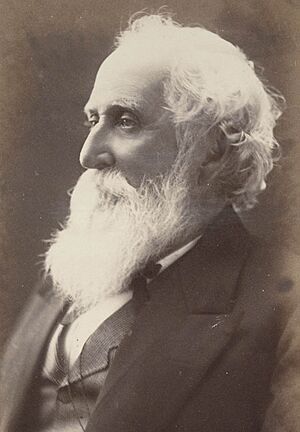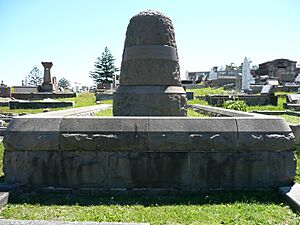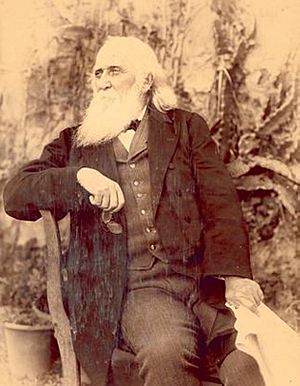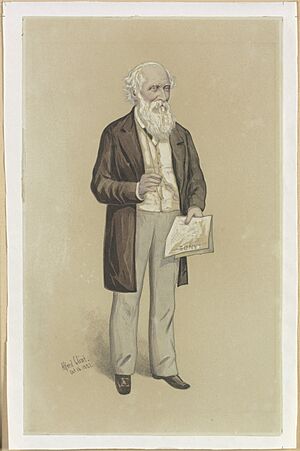John Robertson (premier) facts for kids
Quick facts for kids
Sir John Robertson
|
|
|---|---|

Portrait of Sir John Robertson, c. 1890
|
|
| 5th Premier of New South Wales | |
| In office 9 March 1860 – 9 January 1861 |
|
| Preceded by | William Forster |
| Succeeded by | Charles Cowper |
| In office 27 October 1868 – 12 January 1870 |
|
| Preceded by | James Martin |
| Succeeded by | Charles Cowper |
| In office 9 February 1875 – 21 March 1877 |
|
| Preceded by | Henry Parkes |
| Succeeded by | Henry Parkes |
| In office 17 August – 17 December 1877 |
|
| Preceded by | Henry Parkes |
| Succeeded by | James Farnell |
| In office 22 December 1885 – 22 February 1886 |
|
| Preceded by | George Dibbs |
| Succeeded by | Sir Patrick Jennings |
| Personal details | |
| Born | 15 October 1816 Bow, Middlesex, England |
| Died | 8 May 1891 (aged 74) Watsons Bay, Sydney, Australia |
| Spouse | Margaret Emma "Madge" Davies |
| Children | 9 |
Sir John Robertson (born 15 October 1816 – died 8 May 1891) was an important Australian politician. He was born in London, England, and later became the leader, or Premier of New South Wales, five different times.
Sir John Robertson is best known for changing land laws in New South Wales. These changes, called the Robertson Land Acts of 1861, made it easier for ordinary people to get land. Before this, large landowners, called squatters, controlled most of the land. Robertson wanted to give more people a chance to own their own farms.
He was elected to Parliament in 1856. He supported many new ideas for his time. These included allowing all men to vote, using secret ballots in elections, and making sure voting areas had similar numbers of people. He also wanted to stop government money going to churches and create public, non-religious schools. He believed in free trade and, most importantly, in giving people free access to Crown land (land owned by the government).
Contents
Early Life and Travels
John Robertson was born in Bow, London. He was the fourth child of James Robertson, a watchmaker and farmer from Scotland, and Anna Marie Ripley from England. In 1822, when John was five, his family moved to Australia. They arrived on a ship called the "Providence."
His family was quite well-off. They received a large grant of 2,500 acres (about 10 square kilometers) of land in the Hunter Valley. John's father also worked as a watchmaker for the Governor of New South Wales, Sir Thomas Brisbane. He even received land at a place now called Cremorne Point in Sydney.
John went to several schools in Sydney. Two of his schoolmates, James Martin and William Forster, also became Premiers of New South Wales later on. Around 1833, when he was about 17, John went to sea. He traveled to England, France, and South America.
After two years away, he returned to Australia and joined his family in northern New South Wales. He became involved in farming and raising animals. At 21, he married Margaret Emma "Madge" Davies. They had nine children together – three sons and six daughters. John became known for standing up for smaller farmers against the large landowners, or squatters.
Starting in Politics
In 1856, New South Wales gained "responsible government." This meant the people could elect their own leaders. John Robertson ran for a seat in the New South Wales Legislative Assembly. He promised many changes:
- Allowing all adult men to vote.
- Using secret ballots so people could vote privately.
- Making sure voting areas had similar populations.
- Ending government support for churches.
- Creating public, non-religious schools.
- Supporting free trade.
- Allowing people to choose and settle on Crown land before it was officially surveyed.
Even though he was sick and couldn't campaign much, he won his election. He believed that the land laws were unfair to farmers. He thought that by changing these laws, society could become more balanced. This idea gained him a lot of support from people in both cities and rural areas.
In 1858, he became the Secretary for Lands and Public Works. He helped change election laws, increasing the number of seats in the Legislative Assembly. He was re-elected in 1859.
First Time as Premier
In March 1860, John Robertson became the Premier of New South Wales for the first time. His main goal was to pass his land reform laws. These laws, called the Crown Lands Alienation bill and the Crown Lands Occupation bill, would allow "free selection before survey." This meant people could choose a piece of Crown land and settle on it, even before it was officially measured and mapped.
His first attempt to pass these laws failed. So, he asked the Governor to call a new election in December 1860. He campaigned on the land reform issue, and his party won a clear majority.
In January 1861, he stepped down as Premier but remained Secretary for Lands. This allowed him to focus on getting his land bills passed. The laws passed the Assembly but faced strong opposition in the Legislative Council (another part of Parliament). To overcome this, he convinced the Governor to appoint 21 new members to the Council who supported the land bills. This helped the laws finally pass in October 1861. These land laws were very important and stayed in place for many years.
Robertson continued to serve in Parliament, sometimes resigning and re-entering to deal with personal finances or to represent different areas.
Later Political Life
John Robertson served as Premier four more times after his first term. He was Premier from 1868 to 1870, then again from 1875 to 1877, briefly in 1877, and finally from 1885 to 1886.
He often worked with or against another major politician of the time, Henry Parkes. In 1878, Parkes and Robertson formed a strong partnership. Parkes was Premier, and Robertson became a leader in the Legislative Council. This partnership was very successful and helped pass many new laws.
During this time, in 1879, Robertson helped create the Royal National Park. This was a very important step in protecting natural areas. He was also acting Premier when Henry Parkes was away in England.
Retirement and Legacy
In 1885, Robertson became Premier for the fifth and final time, but he resigned a few months later in February 1886. He had injured his leg while working at the Royal National Park, and this, along with financial problems, led him to retire from Parliament in June 1886. The government gave him a grant of £10,000 to help him.
In his retirement, his health was not good, and he couldn't be as active in public life. He was strongly against the idea of federation, which was the plan to unite the Australian colonies into one country. He believed it would not be good for New South Wales. He even wrote a letter opposing it, which was published on the day he died.
Sir John Robertson passed away on 8 May 1891, in Watsons Bay, Sydney. He was given a public funeral, which showed how important he was to the community.
Honours and Family

In 1877, he was made a Knight Commander of the Order of St Michael and St George (KCMG). This meant he could use the title "Sir."
A statue of Sir John Robertson stands in The Domain near the Art Gallery of New South Wales. Many places are named after him, including:
- The federal voting area called the division of Robertson.
- The former state voting area called the electoral district of Robertson.
- The town of Robertson in the Southern Highlands of New South Wales.
One of his daughters, Margaret-Emma, married a famous Russian scientist and explorer named Nicholas Miklouho-Maclay. He built Australia's first Marine Biological Station in Watsons Bay.
His grandson, Archibald Clark Kerr, became a very important British diplomat in the 20th century.



